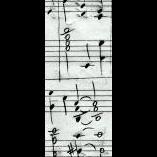Search the Community
Showing results for tags 'counterpoint'.
-
Hi all! It's been a while since I've been on... and I'm returning with a question about Fux's counterpoint from Alfred Mann's The Study of Counterpoint: Are the solutions to each of Aloysius' examples (with corrections) the only acceptable solutions? In attempting to complete the very first exercise (first species counterpoint on the given cantus firmus, in the bottom voice, in dorian mode), I find there are good reasons to rule out most of the consonances that could be considered. However, I don't know if there are hard and fast rules which make the answers that Joseph gives the ONLY possible answers. Anyone have experience with this problem or insights? Thanks!
- 4 replies
-
- counterpoint
- voice leading
-
(and 4 more)
Tagged with:
-
In my ongoing project of composing six small preludes, this one was very difficult to write for me and I am not very satisfied with the result. Basically, it is a canon from measures 1-11 with the upper voice leading, and and then a canon from measures 12-30 with the lower voice leading. M. 1-6 and 12-17 are virtually identical with the voices just exchanged and once in the tonic, then in the dominant (double counterpoint). The tonal plan is C Major -> G Major -> e minor -> G Major -> C Major. Very simple, but it was a new experience for me to change keys in a canon. I wanted to compose it with a hint of moto perpetuo movements, but this didn’t work out. So, without further ado, the prelude in its current state:
-
Christmas is coming... Just for fun I took some traditional melodies, some of them from Spain, and did something with them: CAMPANA SOBRE CAMPANA Partitura completa.pdf Hacia Belén va una Burra Partitura completa.pdf FUN FUN FUN Partitura completa.pdf NOCHE DE PAZ Partitura completa.pdf CAMPANA SOBRE CAMPANA - CAMPANA SOBRE CAMPANA (fuga).mp3 Hacia Belén va una Burra - Hacia Belén va una burra rin-rin (fuga).mp3 FUN FUN FUN - FUN FUN FUN.mp3 NOCHE DE PAZ - NOCHE DE PAZ.mp3
- 6 replies
-
- carols
- counterpoint
-
(and 1 more)
Tagged with:
-
TL;DR underneath. When I first learned things about harmony and voice leading, I learned to avoid parallel and direct fifths and octaves, to avoid dissonances, and things like that, because they're against the rules. I reasoned that the rules weren't arbitrary, so they had to be there for a reason; people want their music to be likeable, things that sound bad aren't likeable, therefore, invent rules to keep music from straying into the boundary of bad. But, as everyone knows, one of the first responses to that is, 'But that doesn't sound bad!', and the reply, 'It diminishes the independence of voices'. When I first learned this, I simply thought there was something wrong with my ears, because I often couldn't spot errors except by sight; however, when I recently began studying counterpoint, I listened to my exercises on Finale and/or played them on the piano, and my rate of mistake-spotting went much higher, along with my finding some things that I particularly disliked. This, obviously wasn't anything to do with hearing them, 'cause I'd been doing that all along with pieces; but I took it to be simplification of texture (I hate octaves or any interval but an imperfect one in two voices, on the beat - three, not so much - four, impossible to avoid in a standard chorale setting). And there were numerous 'exceptions' to the 'rules' (e.g., direct fifths okay between inner voices &c.). Often, these were just things that couldn't be avoided, but I figured that, if they were allowable just because they were unavoidable (Mozart fifths, for example), and some people don't notice them from just hearing the piece, but may spot them by sight, then they can't be that bad! In that spirit, I've posted six short phrases, all in common time and ending with a whole note, that increase gradually in complexity, in a couple of tempos and with a few renderings. I'd like people to listen to them, listen out for mistakes, and post any you spot, here, in a spoiler. You can range from saying what the mistake is and between what voices, or simply stating where it occurs without knowing exactly what it is. Of particular interest is if people can only spot the error in a certain rendering (which I doubt) or a different tempo (which I don't). Please do not use any theoretical skills to work out where they are: this isn't a test or somewhere to show off your aural abilities, and you'll just ruin it for me and everyone else involved. This essentially amounts to listening and pointing out things and/or parts you didn't like. I'll post the score as a spoiler when a tolerable amount of people respond. TL;DR As an experiment in observing the practicality of abstract counterpoint; listen to these six phrases and point out what sounds technically crap. 110 BPM Piano VST Harpsichord VST Piano MIDI 55 BPM Piano VST Harpsichord VST Piano MIDI
- 21 replies
-
- counterpoint
- voice leading
-
(and 2 more)
Tagged with:
-
I was wondering about how to start writing a fugue? I understand they are hard to play, so is there a good process? I mean like composing in front of a piano kind of way. Help appreciated!
-
To improve my skills, I am now in the process of writing a set of six small preludes for piano (or any other keyboard instrument with a range of four octaves) with a contrapuntal flavour. Four of them are somewhat finished, and one of them is this prelude in d minor that is planned as number 6 of the set. It has a rather simple structure that in the literature is sometimes described as reminding of simultaneous double fugues, because the main building block is a small subject and an fixed accompaniment in double counterpoint, quasi a countersubject. The subject and countersubject visit in a quasi-fugal way several keys; these visits are connected by sequences that use some material from the subject or countersubject, though sometimes the relationship is difficult to see or hear. I am still a bit unconvinced by the sequence connecting the subject in g minor and the reprise in d minor, but haven’t found a better solution. The same for the final cadence. Please feel free to comment, criticize etc.
-
Greetings. When I start to compose a piece, I start writing the melody, usually for instruments like flute or violin. Then, when writing melody is done, I start thinking of orchestration and arrangement. I usually harmonize violins like this : Violin I plays the melody I wrote, Violin II plays the same melody one octave lower (and when musescore or other software warns me about notes which are not on the instrument, I just replace them with rests). But, when It comes to other instruments, like Cellos, or Violas, or any other instrument, I really don't know what should I do. These are things I done before : 1. Playing the third of first note of each bar in the viola section (for example if I started violins with G, viola played B for whole bar) 2. Playing the first note of each bar in the Cello/Bass section 3. Playing the fifths in double bass section . And the same for other instruments. And for keep it working well, I just tried to keep my compositions "one chord per bar", at least when I try to write classical music. Is there any tips or advice to improve this? Regards.
-
This piece uses the claves, tambourine, bongos, congas, cabasa, hand clapping, and marimba. It's primarily rhythmic, so the marimba is used sparingly.
-
- 1
-

-
- percussion
- counterpoint
-
(and 1 more)
Tagged with:
-
- 2 replies
-
- canon
- harpsichord
-
(and 1 more)
Tagged with:
-
- 2 replies
-
- harpsichord
- canon
-
(and 1 more)
Tagged with:
-
This is a three voice fugue written for harpsichord. Let me know any thoughts you have about it. Thanks!
- 3 replies
-
- fugue
- counterpoint
-
(and 1 more)
Tagged with:
-
This a short and simple canon for harpsichord written in three part counterpoint. The outer two voices form a strict canon at the octave and the middle voice is in free counterpoint. Let me know what you think!
- 4 replies
-
- harpsichord
- canon
-
(and 1 more)
Tagged with:
-
This little piece uses different contemporary techniques such us random dynamics, interval set, dodecaphonic scales, etc..., in a counterpoint background including canon (octava, motu contrario, prolation).
- 2 replies
-
- rondo
- pitch class set
-
(and 4 more)
Tagged with:
-
It's a kind of " stiff upper lip " litle piece of music
- 2 replies
-
- counterpoint
- joyfull
-
(and 1 more)
Tagged with:
-
I've been writing a pretty large scale orchestral piece lately and I've come upon a section that I'm hoping to have some kind of 12/8 orchestral fugue(Inspired heavily by the double fugue preceding the famous "Ode To Joy" chorus in the final movement of Beethoven's 9th). Here I face two problems: Working out the counterpoint(which is in a minor to make things worse) and figuring out how to orchestrate it. How could one orchestrate counterpoint to avoid voices getting covered up or not blending well as well as keeping the limitations of each instrument in mind. Also, are extra chords not involved in the counterpoint acceptable? If so, how does one manage them and keep them from becoming overbearing against the moving contrapuntal lines?
-
Hi all! In 4 part harmony, moving by an Augmented Second is considered dissonant, even if the interval of 3 semitones is considered consonant. My question is : The dissonance of an augmented second is relative to the musical scale used ? Let's say an E harmonic minor scale for example: If I move a voice from C to D#, it would be dissonant because I'm moving through an Augmented second. But if I leap from E to G, it would be less dissonant because this time I'm using a minor third, even if the number of semitones remains the same (3) . Is this right, if not can someone clarify this to me ? Thanks!
- 6 replies
-
- four-part
- counterpoint
-
(and 1 more)
Tagged with:
-
I am studying Fux's Gradus Ad Parnassum, and I've gotten to the end of the first species. Before I move on to the second, I'd like to try and write a bunch of cantus firmi that I can then harmonize, for practice. The book left me with many questions about how this might be done, so I looked at a few other books and websites. Now I'm sifting through that information (not all of which is in agreement) and trying to put together a set of guidelines. I still have questions, however, and I'm hoping you can help me with some of them. The first deals with outlined intervals. I have read that augmented, diminished, and seventh intervals are not to be outlined, but the Lydian cantus firmus by Fux outlines an ascending minor seventh between notes 5 and 8: Does this mean the outlined m7 is allowed, but not the M7? Another interval allegedly forbidden in outline is the d5, but there's one in Salzer & Schachter's C Aeolian cantus (figure 1-21c) between notes 5 and 8: Is this a mistake? Or is it just that the CF was purposely not written according to "strict" rules? I've carefully analyzed the cantus firmi of Fux, Jeppesen, Salzer & Schachter, Schoenberg, and Schenker, and these are the only questionable outlined intervals I could find. At this point I am leaning toward formulating my rule for outlined intervals as follows: no augmented intervals, no diminished intervals, (even the d5) and no major seventh intervals, but minor seventh intervals are allowed. Does that seem reasonable? Thanks in advance!
- 1 reply
-
- cantus firmus
- gradus ad parnassum
-
(and 2 more)
Tagged with:
-
I know that there is a line that can be written, as the pedal line, but indicating it is the sostenuto pedal. But I have found other scores that seem to call -or could be played with- the sostenuto pedal, without writting the lines. And I was asking myself if that is allowed. Also, if it is allowed, what is the best way to write it. In example, I have these two scores, that have the notes as indicating different instructions for two instruments -as in violins pentagram in an orchestral score-. Mussorgsky, Bilder einer Ausstellung, Promenade: Bach, Praeludium I, BMV 846 At the first one, in the G key pentagram, we can see two white notes, being played at the same time other black notes are played in the same pentagram. At the second one, at the F key pentagram, we can see again two white notes being played, and other notes played too. But you can see that the first one does not have silences for the second instrument to be quiet until played, and the second one does have silences. Obviously there are not a second instrument, and this indicates something that would be played with the same hand. The musescore program lets me put it or make it invisible. So I am not sure what to do here. If I am writing a score that requires the usage of the sostenuto pedal, may I write the sustained notes as if they were a second instrument, and without silences? Is it obligatory to use the pedal line? I think it looks better using the score as if there were two instruments. But I need to know if this would make my score unintelligible. I think it is more elegant than a lot of ligature lines, and easier to understand than a sostenuto pedal line (as you actually show what notes you want to be sustained). I was thinking in things like this: The second seems to be impossible to play without making the other not sustained not at the same time played, be sustained; or stretching a lot the fingers.
- 9 replies
-
- counterpoint
- mussorgsky
-
(and 4 more)
Tagged with:
-
Hello! I'm interested in beginning to compose, especially in modern styles (a la Ligeti). However, my music theory knowledge is minimal... I can read notes and that's about it. (Except sometimes when a note has more than a couple of ledger lines :veryunsure:) Anyway, as I said, I'm into contemporary music... Ligeti, Bartok, and Yun Isang are among my favorite composers. I love listening to their music, but I usually don't get a whole lot out of it since I don't understand the concepts being demonstrated. That being said, can anyone recommend to me a good place to start (e.g. textbook, website) where I could learn music theory? Everything that I've found just explains reading music and then stops. Thanks! P.S. I'm new here... sorry if I'm putting this in the wrong spot.
- 11 replies
-
- beginner
- counterpoint
-
(and 2 more)
Tagged with:
-
Hi everyone, I'm studying counterpoint, and I'm using Alfred Mann's translation of the Gradus ad Parnassum. I have a question about cantus firmi. In my music history classes from college, and in some of the books I've read, a cantus firmus is derived from chant. My question is: HOW is a cantus firmus derived? The melodies I have in books of chant are very, very different from the cantus firmi in the Gradus ad Parnassum. Did Fux use a particular method to modify or rework existing chant melodies in order to use them as cantus firmi? If anyone can help me or point me in the right direction, let me know. Thanks in advance, Clayton
- 2 replies
-
- counterpoint
- chant
-
(and 2 more)
Tagged with:
-
Hello I have recently started to work thorough J. Fux’s Gradus ad Parnassum. I have just completed the first chapter on species one counterpoint, and believe I have understood the majority of it. But there are just a couple of questions I have regarding the text that any help for would be gratefully appreciated. The first is in Fig. 21 on p.39 (Using the 1965 Alfred Mann translation) The student (Joseph) is given a cantus firmus in the mixolydain mode starting on G. In the 11thBar he sharpens the F to and F#. When asked as to why he did this he says: I wanted to write a sixth here. But when I studies singing I learned that Fa leads down and mi leads up. Since the progression moves upwards from the sixth into a third, I have used a sharp in order to emphasize the tendency to ascend. Besides, The F in the eleventh bar would result in a harsh relation with the F# in the thirteenth bar. This answer seems to please his teacher (Aloys). What is meant by far leads down and mi leads up? I understand the need for the F# in the thirteenth bar which creates a Minor third with the leading tone in the upper part, resulting in smooth cadence back to the tonic. But why is a sharp needed in other bars as I thought taking the melody out of he mode was strictly forbidden according to Fux’s rules? If all the F’s are made # would this then just be G major? My second question in relating to Fig. 15 (p.37) In bar 10 to 11 Here 'Joespeth' has brought together both voices from a 10th into an 8va leading them stepwise, the upper part down and the lower up. Aloys refers to this, as Battuta It is apparently wrong why? I thought it was acceptable to move from an imperfect to perfect in contrary motion. Any help on these two questions would be much appreciated. Thank you
-
Hi, is there any guide that describes how to imply functional harmony progressions in contrapuntal music? Most articles on counterpoint seem to be mostly concerned with which intervals are allowed and how dissonances have to be resolved but none explains properly how to combine this approach to composition with functional harmony.
-
Hi, it's the first time I'm posting here, so I hope I'm doing this in the right place. I've taken it onto myself to learn counterpoint from a book that seems thorough enough, Counterpoint in Composition by Salzer and Schachter, but I've been stuck on the first chapter for some time and can't seem to make a decision about how to move on. My question is this: should I master the first species, two voice exercises to make them even, and sounding complete, or be satisfied for now with understanding the rules and move on. I think my difficulty also is in that the authors advise against "mechanical" writing, but I don't get how 8 notes against 8 notes can be anything but mechanical. I'm thinking if I go on then I might understand and hear the whole process better and will be able to write the beginner exercises in a way that's as good as the examples. I wish to go to school for composition soon, but right now I'm limited to studying by myself with the help of only the internet, so there's no point for you to tell me to get a teacher. Thanks!
-
I was recently told on one of my peices that I need to look more into voicing. While I have a vague idea of what this means, I was wondering if someone could give me an overview of what it is (really) and how I can get better at it. Feel free to get nerdy with it, I have Google ;) PS The song is called Silver Linings and can be found with the other band stuff. It would be great if you could listen to it; I need the views and the comments hahaha












